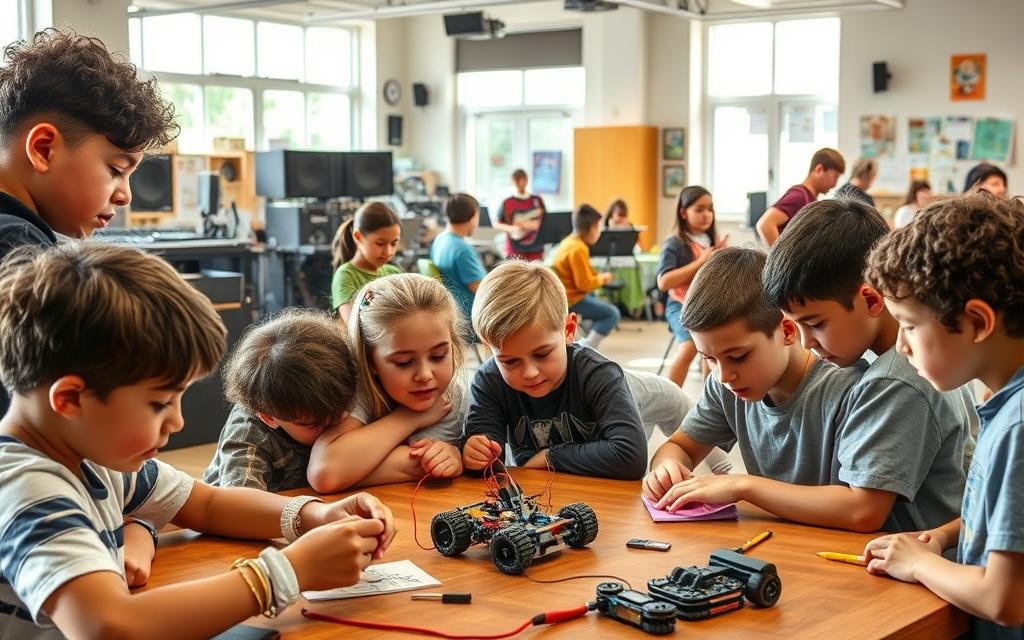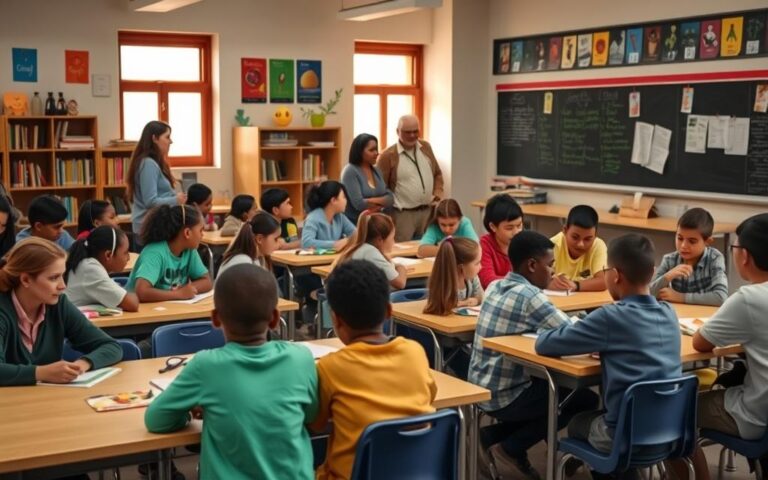advertisement
After-school programs play a big role in how students learn and grow. They help students do better in school, behave well, and stay healthy. These programs lead to better grades, higher test scores, and more homework done.
They also improve attendance, classroom behavior, and important life skills like self-confidence and teamwork.
Millions of kids in the U.S. join these programs every day. Groups like the Afterschool Alliance show that they make a big difference. They help students stay safe and engaged outside of school.
This article is for parents, teachers, and those who make policies. It talks about how to pick the best program, the costs, and new trends in after-school activities.
It covers school programs, community centers, and non-profit activities. You’ll learn about the benefits, how they improve grades, and how they help students make friends. It also talks about how these programs help working parents and the challenges they face.
It shares success stories, how to choose a program, and how to get involved as a volunteer. It also looks at the future of after-school programs.
Introduction to After-School Programs
After-school programs provide structured activities and care for students outside regular school hours. They offer everything from academic tutoring to sports and arts. Many families find these services helpful for balancing work and family life.
Providers include public schools, YMCAs, Boys & Girls Clubs, community nonprofits, private vendors, and faith-based organizations. Formats vary by site: daily attendance, drop-in models, seasonal or project-based offerings, and hybrid virtual/in-person setups that grew after the pandemic.
What are After-School Programs?
At their core, these programs are planned, supervised opportunities that support learning and growth. They include homework help, small-group tutoring, enrichment classes, and recreational activities. After-school care services often follow school calendars and coordinate with teachers to reinforce classroom lessons.
School-based programs usually operate on campus, easing transitions for students. Community centers and private providers add variety with specialized classes in coding, music, and sports. Youth enrichment activities broaden a child’s experiences beyond standard curricula.
The Importance of After-School Engagement
Research from the Afterschool Alliance and RAND Corporation links participation to better attendance, higher homework completion, and gains in math and reading. Regular engagement reduces risky behaviors and supports academic persistence.
Beyond academics, these programs boost social-emotional skills and offer reliable supervision for working parents. Accessibility matters: transportation, scheduling, and alignment with school calendars shape whether families can take part long term.
Benefits of After-School Programs
After-school programs offer a mix of learning, play, and support. They extend the school day in positive ways. Families, teachers, and community groups see gains when children join these programs.
These programs balance tutoring, social skill building, and physical activity. The next parts describe how structured supports and activities combine to boost student success.
Academic Support and Tutoring
Many schools partner with nonprofits and districts to run academic support programs. These programs give students focused help after school. They include small-group tutoring, homework help, and subject-specific remediation in reading, math, and science.
Research shows small groups and regular practice help mastery and test scores. Programs may offer literacy interventions, STEM clubs, or math labs tailored to grade levels. Teachers and tutors use pre/post assessments to track progress and adapt lessons to each learner.
Social Skill Development
Organized activities create safe spaces for children to learn communication, conflict resolution, leadership, and empathy. Clubs and project teams give repeated chances to practice self-regulation and cooperation.
Many programs embed social-emotional learning curricula aligned with CASEL competencies. Staff guide role-play, reflection, and peer feedback so students build resilience and stronger peer relationships over time.
Physical Activity and Health
Sports, dance, and movement-based extracurricular programs raise daily activity. They improve motor skills and support physical health. Regular movement links to better concentration and reduced anxiety in class.
Active programs also improve sleep patterns and classroom behavior. Tracking attendance, activity minutes, and basic health indicators helps programs show impact on both fitness and academic focus.
Cross-benefits emerge when elements work together. Better fitness can sharpen cognitive function and memory. Strong social skills make group learning more productive. Academic support programs that include movement breaks and peer collaboration often see stronger outcomes than isolated efforts.
| Benefit Area | Typical Activities | Measures to Track |
|---|---|---|
| Academic gains | Small-group tutoring, STEM clubs, literacy clinics | Pre/post tests, homework completion, grade changes |
| Social skills | Team projects, SEL lessons, leadership roles | Behavior logs, peer assessments, SEL checklists |
| Physical health | Sports leagues, dance, active recess | Attendance, activity minutes, basic health metrics |
| Combined impact | Integrated clubs that mix tutoring, play, and teamwork | Holistic evaluations, attendance trends, academic and health indicators |
Improving Academic Performance
After-school programs can change how students see schoolwork. They offer structured time, focused staff, and activities tailored to each student. This helps students practice what they learn in class and build confidence.
Increases in Homework Completion
Having structured homework time helps students get help and feedback right away. Trained staff or volunteers guide them, breaking down big tasks into smaller ones. They also provide access to computers and books, helping students understand better.
Studies show that after-school homework help leads to more completed work and better grades. It helps students stay on track and do their work well. Schools with these programs see fewer late assignments and better project results.
Enhanced Learning Environment
Educational after-school programs often have fewer students per teacher. This makes it easier for one-on-one tutoring and hands-on projects. Students can explore ideas in ways they can’t during the school day.
These programs offer both remediation and enrichment. Remediation helps students catch up, while enrichment challenges high-achievers. Both help students do better in school when they match classroom goals.
Working closely with classroom teachers makes these programs even more effective. Teachers share lesson plans and track progress. This ensures students keep learning and growing.
| Focus | Typical Activities | Expected Outcomes |
|---|---|---|
| Remediation | Small-group tutoring, targeted skill drills, guided reading | Fewer gaps in fundamentals, higher test readiness |
| Acceleration | Project-based learning, advanced STEM labs, enrichment clubs | Deeper conceptual understanding, greater academic engagement |
| Homework Support | Supervised work time, access to resources, immediate feedback | Higher completion rates, improved assignment quality |
| Teacher Collaboration | Shared goals, progress tracking, aligned curricula | Consistent learning pathways, measurable improvement |
Building Social Connections
After-school programs bring students together in ways the regular school day often cannot. These programs mix kids from different classes and grades. This expands social networks and makes room for new friendships.
Shy students and recent transfers find low-pressure settings. Here, they can try out conversation skills and feel part of a group.
Making New Friends
Extracurricular programs create shared experiences that spark conversation. When students work side by side in a robotics club or practice lines in theater, natural bonds form. Small-group activities help students practice listening, turn-taking, and empathy.
Schools that run youth enrichment activities often report fewer instances of social isolation. They also see more peer support among participants.
Teamwork and Collaboration
Group projects and team sports teach cooperative problem-solving and shared accountability. Science competitions, theater productions, group art projects, and soccer teams demand planning, strategy, and mutual support. These tasks help young people learn role-taking and conflict resolution.
Well-run school-based programs provide structure that reduces bullying and builds safe spaces. Supervised settings give mentors chances to guide behavior and model respectful interaction. Research links involvement in after-school programs with higher school connectedness and lower disengagement.
Practical features boost social bonding. Mixed-age activities let older students mentor younger peers. Peer leadership roles and mentor matches give students responsibility and confidence.
Extracurricular programs that include cooperative games, service projects, and regular reflection time strengthen friendships and social skills.
Supporting Working Parents
After-school care services fill the gap between school and work hours. Parents want reliable schedules and safe pick-up and drop-off. They also need clear updates through apps or daily reports.
Convenience and Reliability
After-school programs offer transportation and supervised spaces until parents arrive. Many programs have seamless handoffs, making life easier for families. They also ensure safety and quality through staff checks and licensing.
Children enjoy predictable routines in these programs. They get time for homework, snacks, and fun activities. Parents stay updated on their kids’ day through real-time communication tools.
Reducing Childcare Costs
School-based and nonprofit programs are often cheaper than private care. They use grants and sliding-scale fees to make care affordable. Scholarships and partnerships help low-income families too.
Parents save money on childcare when they find affordable programs. This lets them focus on work or school without worrying about emergency costs. Reliable care helps keep jobs and finances stable.
But, some areas face barriers like limited transportation or hours. Extended hours and busing help solve these problems. Accreditation and clear policies build trust with families.
Types of After-School Programs
After-school programs vary to meet different needs and interests. They support learning, creativity, or physical activities. The right mix keeps kids engaged and builds new skills.

Academic Enrichment Programs
These programs focus on homework help, tutoring, and specific subjects. Schools and community centers offer STEM clubs, robotics, and literacy workshops. They aim to close learning gaps and boost confidence.
Students get small-group tutoring, math labs, and science projects. They also prepare for tests. This structure helps them do better in school and develop good study habits.
Creative Arts and Music Classes
Creative arts include visual arts, theater, music, and digital media. These classes foster self-expression and cultural awareness. They also improve fine motor skills.
Students showcase their work in exhibits or performances. This builds pride and community. Arts and music schools partner to provide quality education.
Sports and Physical Activities
Sports and physical activities include teams, dance, and outdoor adventures. They promote fitness, teamwork, and discipline. Seasonal programs ensure safety and skill growth.
Local parks and schools offer many sports options. Regular exercise improves focus and health.
There are also tech clubs, language programs, and career workshops. These add to the after-school choices.
When choosing a program, think about the child’s interests and needs. Look for clear goals, qualified staff, and a supportive environment. This helps families find programs that enhance school performance and personal growth.
Challenges of After-School Programs
After-school programs offer many benefits, but they face big challenges. Funding, staffing, and logistics limit what they can do. This affects families and schools.
Funding Constraints and Their Effects
Grant cycles and local levies make funding unstable. This is tough for community centers and schools. Federal money for enrichment is small, so programs compete for support.
When money gets tight, programs cut hours, materials, or staff. This reduces what they can offer. Fewer STEM clubs and arts classes are available.
Barriers for Low-Income Families
Fees and transportation issues stop low-income families from joining. Even with subsidies, demand is often higher than spots. This is true in areas with the greatest need.
Research shows low-income areas have fewer quality programs. Parents struggle to find out about fee waivers and schedules. This makes it hard for them to enroll their kids.
Staffing, Quality, and Regulatory Hurdles
Finding good teachers is hard and expensive. Training, background checks, and turnover add costs. This disrupts the support students need to grow.
Space and insurance rules limit where programs can go. Meeting safety standards and doing background checks takes time. This adds to the administrative work.
Practical Strategies to Improve Access
Communities can improve by mixing funding models and partnering with businesses and universities. Fee waivers and sliding payments help low-income families. This makes it easier for them to join.
Mobile programs and partnerships with schools reach more areas. Advocating for more funding helps programs stay stable. This is crucial for their success.
Maintaining Quality While Scaling
Investing in staff training and offering good pay helps keep them. Sharing training across districts saves money. This raises standards for programs.
Tracking data on attendance and outcomes shows the value of programs. This attracts more funding. It helps decide where to grow services.
Community Impact of After-School Programs
After-school programs bring families, educators, and organizations together. They create safe spaces for meetings and events. This helps build trust and increases community involvement.
Strengthening Community Ties
These programs offer mentorship from seniors, college students, and teachers. Mentors share their knowledge and life experiences. Youth gain support and learn valuable skills.
They also run volunteer drives. This boosts civic engagement and helps parents connect with schools.
Keeping kids busy in the afternoons reduces crime. Safe activities make neighborhoods safer and foster accountability.
Local Business Support
Local businesses support these programs in many ways. Companies like Target and Starbucks donate resources. Small businesses offer space for workshops and internships.
This support boosts goodwill and provides a talent pool for future employees. It also shows a company’s commitment to the community.
These programs create jobs and help parents work. They also reduce public spending on issues like crime and education.
Successful partnerships include school-park collaborations and university tutoring. These models expand opportunities for youth and strengthen communities.
To measure success, communities track safety, employment, and volunteer hours. These metrics show the positive impact of after-school programs.
| Impact Area | What to Measure | Typical Partners |
|---|---|---|
| Safety | After-school incident rates, youth curfew adherence | Schools, police community liaisons, parks & recreation |
| Employment | Parental workforce participation, paid internships placed | Local employers, chambers of commerce, workforce boards |
| Education & Enrichment | Program attendance, academic support hours, tutor matches | Universities, nonprofits, public libraries |
| Economic | Jobs created, in-kind donations value, sponsorship dollars | Small businesses, corporate sponsors, grantmakers |
| Community Engagement | Volunteer hours, event turnout, cross-sector meetings | Faith groups, community centers, parent-teacher associations |
Success Stories from After-School Programs
After-school programs have a big impact on students and communities. They help students do better in school and build trust in the community. Programs like Boys & Girls Clubs, YMCA, and STEM clubs show real results.
Case Studies of Improved Student Outcomes
Boys & Girls Clubs saw more kids coming to school and doing homework. Math scores went up by 8 to 12 percentage points in a year.
YMCA programs helped with reading and reduced bad behavior. Schools that worked with the YMCA had better focus and smoother days.
STEM clubs made kids more interested in science. Schools with weekly STEM sessions had more students in advanced math and science. Long-term, more students graduated from high school.
Testimonials from Parents and Students
Parents said their kids were more confident and did homework better after joining programs. Homes were quieter and routines clearer.
Students talked about making new friends and finding new interests. Teachers saw better class behavior and more participation.
Program leaders say it’s good to hear from alumni and use surveys. This way, you get real feedback and can make programs better.
| Program | Key Outcome | Measured Metrics | Transferable Element |
|---|---|---|---|
| Boys & Girls Clubs (urban partnership) | Higher math proficiency | Attendance +8%, Math scores +10% | Consistent tutoring schedule |
| YMCA Reading Support (suburban districts) | Improved literacy and behavior | Reading levels up 1.2 grades, Incidents -25% | School-program goal alignment |
| Community STEM Clubs (regional networks) | Increased STEM course enrollment | Advanced course enrollment +15%, Graduation +6% | Hands-on curricula and trained mentors |
Success comes from regular schedules, good staff, clear goals, strong school ties, and family support. Programs that plan for the future and understand the community grow well.
For organizations looking to grow, focus on clear goals and feedback. This builds lasting success in student learning and extracurricular programs.
How to Choose the Right Program
Finding the right program for your child needs a clear plan. Start by making a list of what matters most: academic support, creative play, supervision, or flexible hours. Visit programs, meet staff, and watch a session to see how your child responds.
Use trial days when possible to test fit before committing.
Factors to Consider
Define what you want from the program. Check if it focuses on tutoring or enrichment. Make sure staff is qualified, has background checks, and is well-trained.
Ask about staff-to-student ratios and how they change with age. Review if the program’s goals match your child’s school goals.
Look at the program’s hours, pick-up options, and transportation. Compare costs, sliding-fee plans, and scholarship options.
Check the facility’s quality, safety, and licensing. See if there are clear ways to track your child’s progress.
Questions to Ask
What are the program’s daily goals and schedules? How is staff recruited, trained, and vetted? What is the student-to-staff ratio for my child’s age group?
How are behavior issues and emergencies handled? How does the program communicate with families about attendance, progress, and incidents? What evidence shows academic or social outcomes from the program?
Is there a sliding-fee scale, scholarship option, or subsidized slot for low-income families? Are trial days or observation visits available? What is the policy on absences and refunds?
Match offerings to your child’s learning style, interests, and weekly schedule. Talk with other parents and read recent reviews to learn about real experiences. Watch for red flags like inconsistent communication, frequent staff turnover, unclear curriculum, or opaque fees.
Apply early for subsidized spots and ask about school-based programs tied to transportation. Confirm waitlist procedures and keep backup options in mind when evaluating educational after-school programs and after-school care services that fill quickly.
The Role of Volunteers and Educators
Strong staffing is key to making after-school programs work well and safely. Trained educators bring structure and follow a curriculum. They also manage the classroom. Local volunteers add energy and real-world skills, helping with activities.
Importance of Qualified Instructors
Qualified instructors make learning better by using proven teaching methods and clear checks. They have the right credentials and pass background checks. They also learn about child development and social-emotional learning.
They know their subjects well, helping with math and reading. They also have coaching certifications for sports and physical activities. This keeps staff up-to-date with ongoing training.
Topics include classroom management and culturally responsive teaching. They also learn about trauma-informed care and assessment strategies. Programs follow National AfterSchool Association standards and state professional development to stay safe and quality.
Engaging Community Volunteers
Community volunteers help at a low cost. Colleges, businesses, and civic groups provide mentors and guest presenters. They support homework help, run workshops, or help with logistics.
Managing volunteers well is important. Screen them with background checks and provide orientation. Give them clear roles and ensure supervision. Regular recognition and feedback help keep them committed and build trust.
Combining paid staff with volunteers allows programs to grow without losing quality. This mix offers more academic support, arts, and sports. It keeps costs down.
| Role | Required Qualifications | Typical Duties | Benefits to Program |
|---|---|---|---|
| Certified Instructor | Teaching license or relevant degree, background check | Curriculum delivery, assessment, behavior management | Consistent instruction, aligned academics |
| Program Coordinator | Experience in youth services, training in SEL | Scheduling, staff supervision, compliance | Operational stability, quality control |
| Volunteer Mentor | Background check, orientation | Homework help, one-on-one support, role model | Personalized attention, expanded capacity |
| Guest Presenter | Subject expertise, brief screening | Workshops, career talks, demonstrations | Real-world connections, enrichment |
| Coach | Coaching certification, safety training | Practice plans, skill development, safety oversight | Healthy activity, teamwork skills |
Future of After-School Programs
The future of after-school programs is looking bright. They will be smarter and more inclusive, offering great benefits to students and families. Schools and community groups are combining in-person activities with online tutoring and flexible schedules.
This change makes programs easier for working parents. It also lets districts offer more services without losing quality.
Trends and Innovations
New trends focus on technology, STEM, and learning about feelings and social skills. Classrooms now use coding kits and project-based learning. Online tutoring and data tools help track progress and show results.
Approaches that understand trauma and tailor learning to each student are becoming common. This supports students with different needs.
Advocacy for Continued Support
Funding from the federal and state governments, local bonds, and private donors is crucial. Advocates include parents, teachers, and community leaders. They fight for steady funding, partnerships, and data to show success.
Mobile programs and targeted outreach are reaching more students in need. Investing in after-school programs brings big benefits: more graduates, less crime, and a stronger workforce.
Readers can help by contacting schools about programs, supporting local initiatives, and pushing for policies that help more students. This way, everyone can access quality after-school programs.



